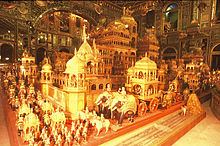Nestled in the heart of the Shekhawati region of Rajasthan, Mandawa is a town that epitomizes the rich cultural heritage and architectural grandeur of the area. Among the many splendid havelis (traditional mansions) that adorn this town, the Goenka Double Haveli stands out for its exquisite beauty and historical significance.
A Historical Overview
The Goenka Double Haveli, also known as the Goenka Twins Haveli, was constructed in the 19th century by the wealthy Goenka merchant family, who were prominent traders in the region. The haveli is a prime example of the opulent lifestyle and artistic patronage of the Marwari merchants of the time.
Architectural Splendor
One of the most striking features of the Goenka Double Haveli is its unique architectural design. Unlike typical single havelis, this structure consists of two distinct sections, each with its own set of courtyards and rooms, hence the name "Double Haveli." The facade of the haveli is adorned with intricate frescoes, a hallmark of Shekhawati architecture. These frescoes depict a wide array of themes, from mythological stories and local legends to scenes of everyday life and portraits of the British colonial rulers.
The haveli showcases the fusion of Rajput and Mughal architectural styles, with elaborately carved wooden doors, latticed windows (jharokhas), and ornate balconies (chhatris). The use of vibrant colors and detailed patterns in the frescoes highlights the artistic brilliance and the cultural richness of the era.
Interior Elegance
Inside the Goenka Double Haveli, visitors are treated to a visual feast of artistry and craftsmanship. The walls and ceilings of the rooms are adorned with frescoes that have retained their vibrancy and detail over the centuries. The themes of these frescoes range from religious motifs, such as depictions of Hindu gods and goddesses, to more secular subjects like the daily life of the local people and the influence of the British Raj.
The haveli’s rooms are furnished with period pieces, including antique furniture, traditional carpets, and ornate chandeliers, providing a glimpse into the luxurious lifestyle of the Marwari merchants. The central courtyards, once bustling with the activities of the household, now serve as tranquil spaces where visitors can pause and soak in the historical ambiance.
Cultural Significance
The Goenka Double Haveli is not just an architectural marvel; it is a cultural repository that reflects the socio-economic history of the Shekhawati region. The frescoes serve as visual narratives that tell stories of the past, offering insights into the lives, beliefs, and aspirations of the people who lived there. The haveli is a testament to the prosperity brought by the trading activities of the Marwari merchants, who played a crucial role in the economic development of Rajasthan and beyond.
Preservation and Tourism
In recent years, efforts have been made to preserve the Goenka Double Haveli and other historical structures in Mandawa. The haveli has been restored to maintain its original charm and integrity, allowing visitors to experience its beauty as it was intended. The town of Mandawa, with its rich collection of havelis, has become a popular tourist destination, attracting travelers from around the world who are eager to explore its architectural treasures.
Visiting the Goenka Double Haveli
For those planning a visit to the Goenka Double Haveli, it is advisable to allocate sufficient time to explore not only this haveli but also the other historical landmarks in Mandawa. The best time to visit is during the cooler months, from October to March, when the weather is pleasant.
Guided tours are available and highly recommended, as they provide valuable insights into the history, architecture, and cultural significance of the havelis. Many of these tours are conducted by local historians or descendants of the original merchant families, offering a personal touch to the storytelling.
Conclusion
The Goenka Double Haveli in Mandawa is a shining example of the rich cultural and architectural heritage of Rajasthan. Its intricate frescoes, elegant design, and historical significance make it a must-visit for anyone interested in exploring the grandeur of India’s past. As a part of the larger Shekhawati region, Mandawa and its havelis offer a unique window into the opulent world of the Marwari merchants and their enduring legacy. Visiting the Goenka Double Haveli is not just a journey into history; it is an immersive experience that captivates the senses and enriches the soul.
Rajasthan Tour Packages
Monuments Rajasthan


































